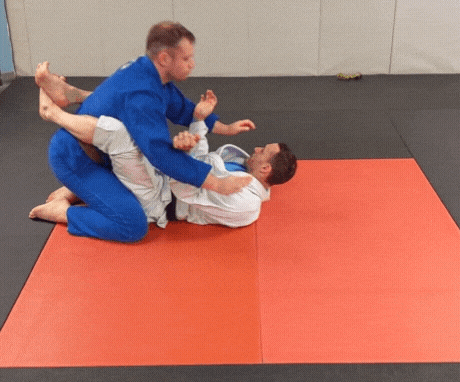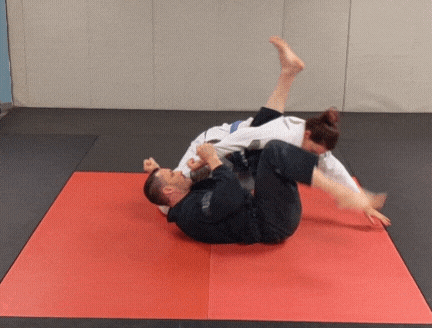Click here for Part 1 and Part 2.
Escapes
Hop over.
When trapped in an omoplata this should be the first choice of escape. It finishes with the best position and is the least risky. A win win. That said, it is often not possible. In this example, Maria has applied the omaplata without first gripping the leg. As a result, there is nothing holding my lower body in place.I could choose to do a forward roll here, but the better option by far is to dip my head as if I was going to roll and hop my legs over her head to land in top side control. This is also possible sometimes the attacker began with a leg grip but let it go to switch to grip the back, or elbow for other reasons. In that moment between grips, we look to jump cross body. If the attacker is fast and rolls to their stomach as we jump we will have effectively swept ourselves, but this is difficult and unlikely.
Hop over omoplata escape
Shoulder roll over the outside arm.
This escape feels very counterintuitive when first used. The immediate desire will be to roll over the trapped arm to relieve the pressure, However, this leads to landing flat on our back and being susceptible to the attacker gaining top side control. Instead, if we roll over our outside shoulder, our roll will take us out of danger but also, swing our legs in an arc allowing us to come to our knees in front of our opponent. Here we have some guard passing work to do so it is not as desirable as the hop over escape, but it is still a much better position.
Shoulder roll omoplata escape
Pass under the far leg
This is the escape I use most because it works best against omoplatas that are applied well. The goal of this escape is to win the far footpull it over our head and ‘tunnel’ our way to the far side. The first step is to stay safe. We do this by defending our arm by grabbing our pants or linking our hands. Next if we can see that their far foot is within our reach we grab it, but most often it will not be. In order to bring the foot closer, we look to posture up and force the attacker to their back. Doing so should allow us to reach the foot. Once we have the foot we pull the leg over our head and tight to our neck. If we slide our hand down to their toes here and pull down while bridging up we can apply a kind of cheap toe hold. Although this usually just serves to motivate the person to give up the pass, it can actually damage the ankle so don’t be shocked if they tap. But, our main goal is to escape not to submit. Keeping pressure on the leg with our head and neck, we let go of the foot, switch our hips, and drive ourselves into side control on the far side. This is a great escape because it is also a guard pass, but there are possible counters here which make it again less desirable than the hop over.
Far side duck under omoplata escape
Counters
Knee bar.
This comes up most when we enter the omoplata with a grip on the ankle to start or if we have switched to attack the toe hold. In both cases because we don’t have a back grip or a good thigh grip it is easier for our opponent to forward roll. Here as I look to attack the toe hold, Chris does a forward roll to escape. While he rolls I look to adjust my legs so that my inside leg catches on the crest of his hip and my outside leg wraps around to post on his far thigh. Hugging his leg tight, I look to improve my position by securing his big toe with the side of my neck and replacing my inside leg to the outside with the other. From here we bridge for our finish.
Kneebar counter to a forward roll from omoplata
Modified finish against an opponent looking to posture
If when we have entered the omoplata, our opponent is aggressively looking to posture by posting their hand on the mat, we can attempt an alternate finish. With our legs triangled, we turn 90 degrees to face them and look to fish the free foot across their body and under their armpit. From here we sit up and place both hands behind us on the mat. To finish we straighten our head side leg and drive the knee of the hip side leg toward the ground and into their shoulder. This is best done by sitting up in a crunch, not by bridging. If when we apply this version of the lock, our opponent begins to descend and lay flat on the mat it can be hard to finish, but now they are no longer posturing and there is nothing stopping us from returning to our conventional finish.
Modified omoplata finish against posting opponent
Scarecrow
This is a counter to the last escape listed. When they reach for our foot, we pull it back to us, and secure a grip on their hand or jacket. With this in place, we pass our leg from one side of their head where it is engaged in the omoplata to the other and have it snake under the far arm. Our free foot goes back on the mat and we shrimp while simultaneously extending our high leg and pullin on our wrist grip. It’s fancy but it works. Keep this in mind when you go hunting for that foot to escape.
Scarecrow finish against opponents foot grip. Made famous by Clark Gracie.
Back roll to top side control
Another defense to the last escape, the back roll takes us once again to top side control. When our opponent sits up with posture and puts us to our back, they most often will bring their feet forward as well. This allows them to move quickly to the far side and complete the pass, it also removes their base behind them. Once their feet are in front, we can secure the elbow with a grip post on the mat and do a back shoulder roll to land on top again. Note, the moment we switch our grip to the elbow we will no longer have any grips on the back or lower body, a smart opponent may look to go back to our first hop across escape. That is why it is advisable not to set up your back roll until you are sure their legs are in front of them making it harder to hop over.
Back roll recovery against postured opponent.









